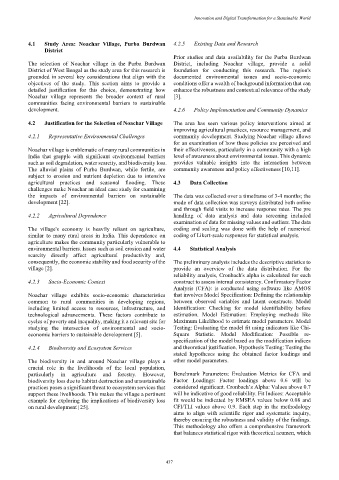Page 481 - Kaleidoscope Academic Conference Proceedings 2024
P. 481
Innovation and Digital Transformation for a Sustainable World
4.1 Study Area: Noachar Village, Purba Burdwan 4.2.5 Existing Data and Research
District
Prior studies and data availability for the Purba Burdwan
The selection of Noachar village in the Purba Burdwan District, including Noachar village, provide a solid
District of West Bengal as the study area for this research is foundation for conducting this research. The region's
grounded in several key considerations that align with the documented environmental issues and socio-economic
objectives of the study. This section aims to provide a conditions offer a wealth of background information that can
detailed justification for this choice, demonstrating how enhance the robustness and contextual relevance of the study
Noachar village represents the broader context of rural [3].
communities facing environmental barriers to sustainable
development. 4.2.6 Policy Implementation and Community Dynamics
4.2 Justification for the Selection of Noachar Village The area has seen various policy interventions aimed at
improving agricultural practices, resource management, and
4.2.1 Representative Environmental Challenges community development. Studying Noachar village allows
for an examination of how these policies are perceived and
Noachar village is emblematic of many rural communities in their effectiveness, particularly in a community with a high
India that grapple with significant environmental barriers level of awareness about environmental issues. This dynamic
such as soil degradation, water scarcity, and biodiversity loss. provides valuable insights into the interaction between
The alluvial plains of Purba Burdwan, while fertile, are community awareness and policy effectiveness [10,11].
subject to erosion and nutrient depletion due to intensive
agricultural practices and seasonal flooding. These 4.3 Data Collection
challenges make Noachar an ideal case study for examining
the impacts of environmental barriers on sustainable The data was collected over a timeframe of 3-4 months; the
development [22]. mode of data collection was surveys distributed both online
and through field visits to increase response rates. The pre
4.2.2 Agricultural Dependence handling of data analysis and data screening included
examination of data for missing values and outliers. The data
The village's economy is heavily reliant on agriculture, coding and scaling was done with the help of numerical
similar to many rural areas in India. This dependence on coding of Likert-scale responses for statistical analysis.
agriculture makes the community particularly vulnerable to
environmental barriers. Issues such as soil erosion and water 4.4 Statistical Analysis
scarcity directly affect agricultural productivity and,
consequently, the economic stability and food security of the The preliminary analysis includes the descriptive statistics to
village [2]. provide an overview of the data distribution. For the
reliability analysis, Cronbach's alpha is calculated for each
4.2.3 Socio-Economic Context construct to assess internal consistency. Confirmatory Factor
Analysis (CFA): is conducted using software like AMOS
Noachar village exhibits socio-economic characteristics that involves Model Specification: Defining the relationship
common to rural communities in developing regions, between observed variables and latent constructs. Model
including limited access to resources, infrastructure, and Identification: Checking for model identifiability before
technological advancements. These factors contribute to estimation. Model Estimation: Employing methods like
cycles of poverty and inequality, making it a relevant site for Maximum Likelihood to estimate model parameters. Model
studying the intersection of environmental and socio- Testing: Evaluating the model fit using indicators like Chi-
economic barriers to sustainable development [5]. Square Statistic. Model Modification: Possible re-
specification of the model based on the modification indices
4.2.4 Biodiversity and Ecosystem Services and theoretical justification. Hypothesis Testing: Testing the
stated hypotheses using the obtained factor loadings and
The biodiversity in and around Noachar village plays a other model parameters.
crucial role in the livelihoods of the local population,
particularly in agriculture and forestry. However, Benchmark Parameters: Evaluation Metrics for CFA and
biodiversity loss due to habitat destruction and unsustainable Factor Loadings: Factor loadings above 0.6 will be
practices poses a significant threat to ecosystem services that considered significant. Cronbach’s Alpha: Values above 0.7
support these livelihoods. This makes the village a pertinent will be indicative of good reliability. Fit Indices: Acceptable
example for exploring the implications of biodiversity loss fit would be indicated by RMSEA values below 0.08 and
on rural development [25]. CFI/TLI values above 0.9. Each step in the methodology
aims to align with scientific rigor and systematic inquiry,
thereby ensuring the robustness and validity of the findings.
This methodology also offers a comprehensive framework
that balances statistical rigor with theoretical acumen, which
– 437 –

